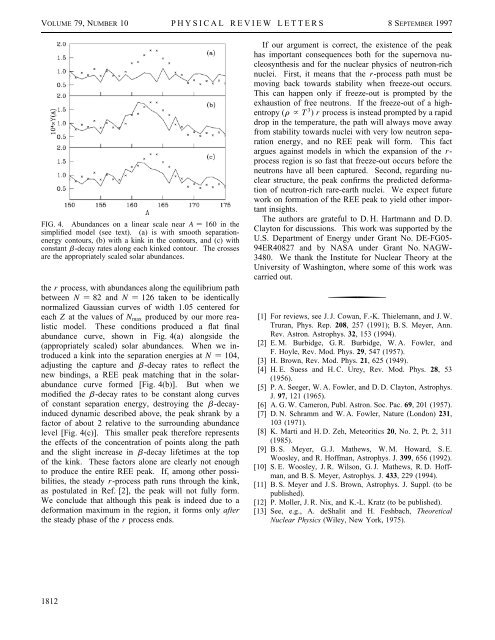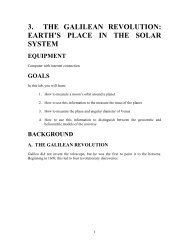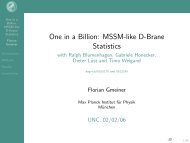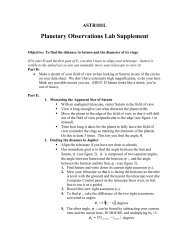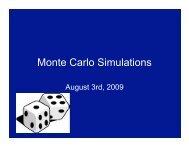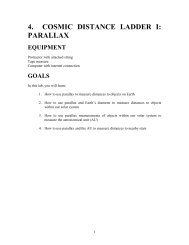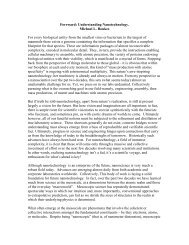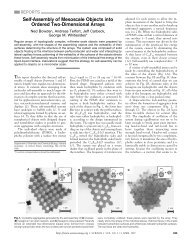Source of the Rare-Earth Element Peak in r-Process Nucleosynthesis
Source of the Rare-Earth Element Peak in r-Process Nucleosynthesis
Source of the Rare-Earth Element Peak in r-Process Nucleosynthesis
Create successful ePaper yourself
Turn your PDF publications into a flip-book with our unique Google optimized e-Paper software.
VOLUME 79, NUMBER 10 PHYSICAL REVIEW LETTERS 8SEPTEMBER 1997<br />
FIG. 4. Abundances on a l<strong>in</strong>ear scale near A 160 <strong>in</strong> <strong>the</strong><br />
simplified model (see text). (a) is with smooth separationenergy<br />
contours, (b) with a k<strong>in</strong>k <strong>in</strong> <strong>the</strong> contours, and (c) with<br />
constant b-decay rates along each k<strong>in</strong>ked contour. The crosses<br />
are <strong>the</strong> appropriately scaled solar abundances.<br />
<strong>the</strong> r process, with abundances along <strong>the</strong> equilibrium path<br />
between N 82 and N 126 taken to be identically<br />
normalized Gaussian curves <strong>of</strong> width 1.05 centered for<br />
each Z at <strong>the</strong> values <strong>of</strong> N max produced by our more realistic<br />
model. These conditions produced a flat f<strong>in</strong>al<br />
abundance curve, shown <strong>in</strong> Fig. 4(a) alongside <strong>the</strong><br />
(appropriately scaled) solar abundances. When we <strong>in</strong>troduced<br />
a k<strong>in</strong>k <strong>in</strong>to <strong>the</strong> separation energies at N 104,<br />
adjust<strong>in</strong>g <strong>the</strong> capture and b-decay rates to reflect <strong>the</strong><br />
new b<strong>in</strong>d<strong>in</strong>gs, a REE peak match<strong>in</strong>g that <strong>in</strong> <strong>the</strong> solarabundance<br />
curve formed [Fig. 4(b)]. But when we<br />
modified <strong>the</strong> b-decay rates to be constant along curves<br />
<strong>of</strong> constant separation energy, destroy<strong>in</strong>g <strong>the</strong> b-decay<strong>in</strong>duced<br />
dynamic described above, <strong>the</strong> peak shrank by a<br />
factor <strong>of</strong> about 2 relative to <strong>the</strong> surround<strong>in</strong>g abundance<br />
level [Fig. 4(c)]. This smaller peak <strong>the</strong>refore represents<br />
<strong>the</strong> effects <strong>of</strong> <strong>the</strong> concentration <strong>of</strong> po<strong>in</strong>ts along <strong>the</strong> path<br />
and <strong>the</strong> slight <strong>in</strong>crease <strong>in</strong> b-decay lifetimes at <strong>the</strong> top<br />
<strong>of</strong> <strong>the</strong> k<strong>in</strong>k. These factors alone are clearly not enough<br />
to produce <strong>the</strong> entire REE peak. If, among o<strong>the</strong>r possibilities,<br />
<strong>the</strong> steady r-process path runs through <strong>the</strong> k<strong>in</strong>k,<br />
as postulated <strong>in</strong> Ref. [2], <strong>the</strong> peak will not fully form.<br />
We conclude that although this peak is <strong>in</strong>deed due to a<br />
deformation maximum <strong>in</strong> <strong>the</strong> region, it forms only after<br />
<strong>the</strong> steady phase <strong>of</strong> <strong>the</strong> r process ends.<br />
If our argument is correct, <strong>the</strong> existence <strong>of</strong> <strong>the</strong> peak<br />
has important consequences both for <strong>the</strong> supernova nucleosyn<strong>the</strong>sis<br />
and for <strong>the</strong> nuclear physics <strong>of</strong> neutron-rich<br />
nuclei. First, it means that <strong>the</strong> r-process path must be<br />
mov<strong>in</strong>g back towards stability when freeze-out occurs.<br />
This can happen only if freeze-out is prompted by <strong>the</strong><br />
exhaustion <strong>of</strong> free neutrons. If <strong>the</strong> freeze-out <strong>of</strong> a highentropy<br />
(r ~T 3 )rprocess is <strong>in</strong>stead prompted by a rapid<br />
drop <strong>in</strong> <strong>the</strong> temperature, <strong>the</strong> path will always move away<br />
from stability towards nuclei with very low neutron separation<br />
energy, and no REE peak will form. This fact<br />
argues aga<strong>in</strong>st models <strong>in</strong> which <strong>the</strong> expansion <strong>of</strong> <strong>the</strong> r-<br />
process region is so fast that freeze-out occurs before <strong>the</strong><br />
neutrons have all been captured. Second, regard<strong>in</strong>g nuclear<br />
structure, <strong>the</strong> peak confirms <strong>the</strong> predicted deformation<br />
<strong>of</strong> neutron-rich rare-earth nuclei. We expect future<br />
work on formation <strong>of</strong> <strong>the</strong> REE peak to yield o<strong>the</strong>r important<br />
<strong>in</strong>sights.<br />
The authors are grateful to D. H. Hartmann and D. D.<br />
Clayton for discussions. This work was supported by <strong>the</strong><br />
U.S. Department <strong>of</strong> Energy under Grant No. DE-FG05-<br />
94ER40827 and by NASA under Grant No. NAGW-<br />
3480. We thank <strong>the</strong> Institute for Nuclear Theory at <strong>the</strong><br />
University <strong>of</strong> Wash<strong>in</strong>gton, where some <strong>of</strong> this work was<br />
carried out.<br />
[1] For reviews, see J. J. Cowan, F.-K. Thielemann, and J. W.<br />
Truran, Phys. Rep. 208, 257 (1991); B. S. Meyer, Ann.<br />
Rev. Astron. Astrophys. 32, 153 (1994).<br />
[2] E. M. Burbidge, G. R. Burbidge, W. A. Fowler, and<br />
F. Hoyle, Rev. Mod. Phys. 29, 547 (1957).<br />
[3] H. Brown, Rev. Mod. Phys. 21, 625 (1949).<br />
[4] H. E. Suess and H. C. Urey, Rev. Mod. Phys. 28, 53<br />
(1956).<br />
[5] P. A. Seeger, W. A. Fowler, and D. D. Clayton, Astrophys.<br />
J. 97, 121 (1965).<br />
[6] A. G. W. Cameron, Publ. Astron. Soc. Pac. 69, 201 (1957).<br />
[7] D. N. Schramm and W. A. Fowler, Nature (London) 231,<br />
103 (1971).<br />
[8] K. Marti and H. D. Zeh, Meteoritics 20, No. 2, Pt. 2, 311<br />
(1985).<br />
[9] B. S. Meyer, G. J. Ma<strong>the</strong>ws, W. M. Howard, S. E.<br />
Woosley, and R. H<strong>of</strong>fman, Astrophys. J. 399, 656 (1992).<br />
[10] S. E. Woosley, J. R. Wilson, G. J. Ma<strong>the</strong>ws, R. D. H<strong>of</strong>fman,<br />
and B. S. Meyer, Astrophys. J. 433, 229 (1994).<br />
[11] B. S. Meyer and J. S. Brown, Astrophys. J. Suppl. (to be<br />
published).<br />
[12] P. Moller, J. R. Nix, and K.-L. Kratz (to be published).<br />
[13] See, e.g., A. deShalit and H. Feshbach, Theoretical<br />
Nuclear Physics (Wiley, New York, 1975).<br />
1812


